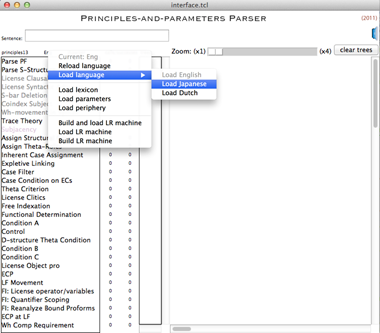
[Click on image to enlarge.]
Let's select Japanese (Jp). If the language-particular files are
successfully loaded, you will see Jp displayed in place
of Eng.
Let's type in an example Japanese sentence using Romaji:
(1)
| neko-ga | koroshita | nezumi-ga | tabeta | tiizu-wa | kusatte | ita |
| cat-nom | kill-past | rat-nom | eat-past | cheese-topic | rotten | was |
In Japanese, the recursively embedded relative clause structure is grammatical but the corresponding sentence is 'unnatural' in English. A possible explanation for the unnaturalness is that English SVO word order results in a center-embedded structure, in which each subject can be gapped from its associated verb by adding a relative clause modifying the subject. In contrast, because Japanese is a head-final language, the recursive embedding of the relative clause does not separate the subject from its verb. See the Japanese parse below:
Let's switch the language back to English by clicking on Jp:

Let's type in the following English sentences:
| (2) a. | The cheese was rotten |
| b. | The cheese the rat ate was rotten |
| c. | The cheese the rat the cat killed ate was rotten |
In terms of 'naturalness', examples (2a-b) contrast with example (2c). PAPPI implements a theory of competence not performance. All three sentences are deemed grammatical by the parser.
The corresponding parses are shown below:

|

|

Just for fun, let's see what Google Translate makes of the two sentences. From Japanese to English:
The reason why we get the wrong word order, e.g. Cheese mouse..., is that, as far as we know, Google Translate's language model does not use (hierarchically-based) phrase structure.
From English to Japanese:
If you are a native speaker of Japanese, is this sentence good for you?
P.S. I've been informed that the sentence is fine if the first case particle is change to the dative instead of the nominative:
猫に殺されたラットが食べたチーズが腐った。
neko-ni korosareta rato-ga tabeta chizu-ga kusata
cat-Dat was-killed rat-Nom ate cheese-Nom rotted
'The cheese that the rat that was killed by the cat ate rotted.'
However, Google Translate doesn't do well on this last sentence either:

Now we have cheese rat killing the cat...